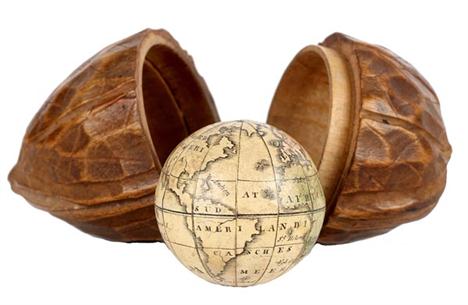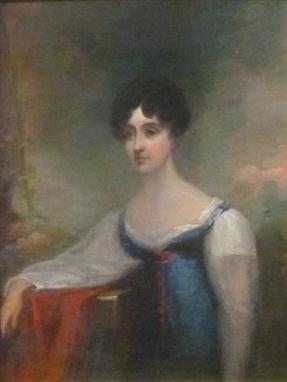A rare German 1.25 inch miniature terrestrial globe. Carl Bauer, Nuremburg, early 19th century. The sphere applied with twelve printed gores with continents and principal landmasses outlined, coloured and annotated in German, the South Pacific near Cape Horn with printed monogram MCB, in original carved wood case modelled as a walnut, 6.5cm (2.5ins) high. Carl Johann Sigmund Bauer was born in 1780 to globe maker and engraver Johann Bernard; he had a brother, Peter, who was three years younger. Both Peter and Carl followed in their father’s footsteps and perhaps became best known for producing the educational aid ‘The World and its Inhabitants’. This usually comprised a 1.75 inch globe and a hand coloured series of portraits depicting people of different ethnic backgrounds bound as a concertina foldout. Carl died in 1857, outliving his younger brother by ten years. The current lot is notable in that still retains its original case which is carved to resemble a walnut. The current lot appears a photographic reproduction of the famous portrait engraved by John Smith after the original by Sir Godfrey Kneller circa 1710.
283284 Preisdatenbank Los(e) gefunden, die Ihrer Suche entsprechen
283284 Lose gefunden, die zu Ihrer Suche passen. Abonnieren Sie die Preisdatenbank, um sofortigen Zugriff auf alle Dienstleistungen der Preisdatenbank zu haben.
Preisdatenbank abonnieren- Liste
- Galerie
-
283284 Los(e)/Seite
Thomas Tompion -a photolithographic portrait. Reproduced from the mezzotint portrait engraved by John Smith after Kneller, 20th century. The likeness wearing a wig and buttoned jacket holding a watch movement in his right hand, within oval reveal and entitled Tho: Tompion. Automatopoeus to lower border and bearing inscriptions G: Kneller Eques. Pinx: and I: Smith fe: et ex: to lower margin, the image 34.5 x 25cm (13.5 x 9.5ins) approx. framed and glazed. An almost identical dial provenanced to the family of Nevil Maskelyne was sold by at Christie’s, South Kensington, Travel, Science and Natural History, 25th April 2012, Lot 70 for £4,000. The current lot appears a photographic reproduction of the famous portrait engraved by John Smith after the original by Sir Godfrey Kneller circa 1710.
A fine George III brass mounted ebonised quarter chiming musical table clock. Paul Rimbault, London, late 18th century. The substantial six pillar triple fusee movement with verge escapement and chiming the quarters on eight bells and playing a choice of two tunes including ‘Oh Worship the King!’ on the same eight bells with fifteen hammers on the hour, the symmetrical foliate scroll and strapwork engraved backplate with external fly with adjustable vanes for regulating the speed of the music and conforming decorative backcock apron, the 7 inch wavy-outline arched Roman numeral painted dial signed PAUL RIMBAULT, LONDON to centre and with scroll pierced blued steel hands within spandrels decorated with delicate floral sprays on a dark ground, beneath arch finely painted with a landscape view of a church beside a river with a sailing boat and bridge beyond, the inverted bell top case with figural surmount cast as ‘Britannia’ set on a pedestal applied with side scrolls over foliate festoon mount to the concave section of the superstructure flanked by cast vase finials to corners, with pierced and engraved foliate brass frets to upper quadrants of the brass fillet inset front door flanked by ribbon bow and entwined husk drapery cast mounts incorporating relief portrait medallions to front angles, the sides with hinged handles above arched fishscale frets and with conforming mounts to rear canted angles, on brass-bound shallow cavetto moulded skirt base with brass bracket feet, 48cm (19ins) high excluding figural surmount, 60cm (23.5ins) high overall. Paul Rimbault is recorded in Baillie, G.H. Watchmakers & Clockmakers of the World as working from Denmark Street, London 1770-85. He was related to John Stephen Rimbault who is recorded working from Great St. Andrew’s Street, London 1744-85. Both makers probably had Huguenot roots and appear to have specialised in the production of complex musical clocks which often incorporated automata within the arch of the dial. The current lot can be traced back within the vendor’s family until at least mid 19th century and it is possible that the clock has remained in the same family since it was made; this is perhaps supported by the fact that it survives in good, relatively unrestored original condition. With a dial width of seven inches the current lot is also perhaps of a more manageable size than many musical clocks from this period which tended to be of larger proportions, however it still remains a highly decorative thus impressive object.
Four: Military Cross, Geo V first type (un-named), 1914-15 star (erased), BWM and Victory (Lieut W E McNamara), with relevant miniatures. VF. Together with Commission document as 2nd Lieut 26th April 1915 (18th Bn Royal Welsh Fusiliers 2nd London Welsh Battalion); ditto dated 5th December 1919 as Captain Indian Army Reserve of Officers; Articles of Agreement as a Temporary Officer in Supply and Transport Corps of Indian Army 25th November 1919, and various other ephemera including portrait photo of McNamara, a “Rolls” razor set and an attractive base metal openwork cigarette case depicting Egyptian scenes stated to have belonged to McNamara’s son. See lots 677 and 678 for other family related items. Note: MC London Gazette 14th November 1916 “Temp Lt William Edward McNamara Gen List attd RE. For Conspicuous gallantry in action. He laid and repaired cables under very heavy fire, displaying great courage and initiative throughout”.
A well executed head and shoulders miniature portrait, c 1820, of a senior naval officer, without hat, wearing high necked collar, cravat, epaulettes, etc, in velvet lined maroon leather case with lid, 2¾” x 2¼” x½”, and a gold coloured cravat pin, pointed oval head with enamel beaded edge. GC Plate 3
An attractive and well executed late 19th century Imperial German embroidered panel, being a souvenir of military service, bearing a photograph of a soldier in uniform in the centre, a coloured portrait of the Kaiser above, and inscribed “Rust einst das Vaterland uns wieder/ ab Reservist and wehrmann/ sol legen wir die Arbeit nieder/ Und folgen treu der Fahre dann”, and with a printed panel at the base “Zur Erinnerung an meine Dienstzeit”, 11½” x 15½”, in a modern wood frame, but the back with old label of R Ledermann, Erfurt. Near VGC
A WWII US Aircrew leather jacket, silk lining, zip front, 2 stud fastening pockets, with insignia: name tag “Lt G Bartling” and Flying Tigers roundel, “American Volunteer Group - Burma China 1941-1942” to chest, “China- Burma- India” shield to left shoulder, and Blood chit panel to back, with photostat of various blood chits; and a framed studio photo portrait of 2nd Lt Mark L MacDonnell, wearing Port of Embarkation shoulder flash, together with his identity card, d 1944, collar disc, 4 WWII medals, 2 bars medal ribbons, and photostat details. GC
A Dieppe sculpted ivory mounted desk thermometer, last quarter 19th century, modelled with the standing figure of a soldier in Mediaeval armour on a capital with moulded edging, the shaft below with thermometre to the front and fluted to the reverse, 23.5cm high; a gilt metal profile portrait of Arthur Wellesley, first Duke of Wellington, circa 1815, with sinister showing and the wording ‘FIELD MARSHALL MARQUIS WELLINGTON, EL DUQUE DE CIUDAD RODERIGO’, within a rectangular ebonised papier mache frame, 14.5cm high overall; a bronze portrait bust of Admiral Lord Nelson, early 20th century, 18.5cm high; an Austrian circular bone box containing four gilt metal tokens, late 19th century, 2.5cm diameter; a Berlin porcelain portrait miniature, late 19th century, within a carved softwood mount, 20cm high overall; a Victorian turned and part stained bone Barleycorn Pattern chess set, mid 19th century, the kings 9.7cm high; and other items
A group of five Limoges enamel on copper panels, probably 18th century, the central depiction of Saint Theresa on a rectangular panel surrounded by four depictions of the emperors Vitellius, Tiberius, Caligula and Galba on smaller, oval panels, later mounted and framed on a single lozenge shaped panel and glazed, 51cm high overall, 45.5cm wide overall; a Limoges enamel on copper circular portrait panel depicting a youth in Renaissance dress, probably 19th century, portrayed in profile with dexter showing, his red, gold and green hat with feathers, above a purple coat with high collars, later set into an ebonised wood slip and a square, parcel gilt wood moulding frame, the enamel 13.5cm diameter, the frame 19cm square; and a Limoges enamel on copper portrait of Saint Francis Xavier, possibly 18th century, portrayed in an oval reserve on a rectangular ground, set within an ebonised and parcel gilt wood moulding frame, 17.5 x 15.5cm overall
A Victorian painted porcelain and gilt metal mounted plaque, signed ‘M Breton 1841’, oval portrait miniature depicting a gentleman, within an ornate beaded and engraved gilt metal frame, the reverse with applied printed paper label ‘Valette Fabricant de Cadres Rue Groix-des-Petit Champs, 41, Assortment de contems pour Penture et Dessin, A Paris, 14cm x 13cm
*Francis Bruguiere (1880-1945), CUT PAPER ABSTRACTION 1931, gelatin silver print, credit and date in pencil verso 21 x 2.6cm. Provenance: Weston Gallery Carmel, USA. Francis Bruguiere was born in San Francisco in 1879 (some say 1880). In 1905, he became friends with Frank Eugene and Alfred Stieglitz and became a nominal Photo-Secessionist. A year later, he opened a portrait studio in San Francisco where he was born, but returned to New York in 1919 to work for Vanity Fair, Vogue, Harper’s Bazaar and the New York Theatre Guild. In 1923, Bruguiere began to photograph shaped or cut-paper designs, dramatically lit to create patterns and movement in abstract forms of light and shadow. He came to London from the USA already known as a photographer and with one completed film, and in London he produced the first British abstract film, ‘Light Rhythm’. It is a strictly abstract work which added new dimensions to these shapes: moving light-sources, a scheme of superimpositions, and the elements of time and music. Influenced by Synchromist paintings, he continued to work with cut-paper abstractions until 1937.
Approx thirty two LP vinyl records by Bob Dylan and Johnny Cash, records by Bob Dylan include 'Greatest Hits', 'Self Portrait', 'John Wesley Harding', 'Nashville Skyline', 'Highway 61 Revisited', 'Live at Budokan', 'Street Legal', 'Freewheelin', plus approx six others, many reissues Records by Johnny Cash include 'Blood Sweat Tears' plus approx seventeen others, overall condition good to very good
A limited edition Buzz Aldrin, 25th anniversary 'First Man on the Moon' watch, this limited edition watch has been authorised by Buzz Aldrin, first of the United States explorers, this watch commemorates the 25th anniversary of man's first steps on the moon with certificate no.1105/25000 which reads 'This is to certify that under my supervision, I witnessed the insertion of metals including the skin from the Apollo 11 Spacecraft Columbia CM107, which was authenticated by the Lunar Receiving Decontamination Team of Apollo 11, until moulding and manufacture work complete', signed Arthur C Koon, Inspector US Testing, SGS, boxed with original paperwork and cardboard box, also a T.W.M. Precision quartz, 'A Piece of the Moon Landing' wrist watch, the dial with a portrait of the moon and piece of moon rock inserted at the twelve o'clock, boxed, also a Fisher space pen (3)
Pair of Victorian Staffordshire portrait figures on horseback, `Prince of Wales` and `Princess` , both sparsely coloured to faces on oval plinth bases, (one a/f) together with a Staffordshire figure of lady in crinoline dress by Goldscheider, Royal Dux porcelain figurine and a Continental pottery figure of a young girl (5)
-
283284 Los(e)/Seite























































